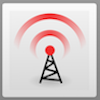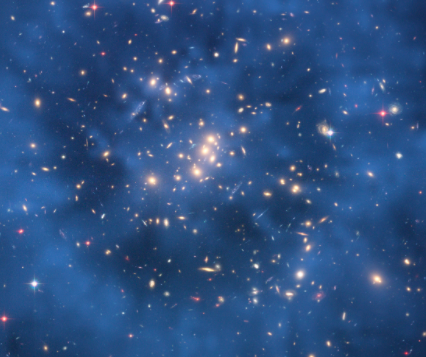Friday Flyer - October 30, 2020
First-Ever Special Dark Matter Issue

Spotlight on Dark Matter
What do we know? Not much. We cannot detect dark matter directly—so far—but we have a pretty good idea that it exists from astrophysics. In 1933, Fritz Zwicky found a gravitational anomaly in the Coma cluster of galaxies; he calculated that the gravitational mass of the galaxies was 400 times the luminous mass and suggested dark, cold, unseen matter as the explanation. In the 1970s, Vera Rubin looked at galactic rotation curves and found that they would only work out if each galaxy had a spherical halo of unseen matter well in excess of stars, dust, and gas found in the spiral structure. Subsequently, scientists have observed gravitational lensing due to dark matter as well.
But what is it? Well, dark matter has mass and interacts via gravity, but we cannot see dark matter because it does not interact electromagnetically. And the calculated density of neutrinos is not enough to make them a candidate. One popular idea is weakly interacting massive particles (WIMPs) which might only be detected, like neutrinos, via the weak interaction. Or not. So far, dark matter detection experiments do not have firm evidence of WIMPs. Other possibilities are small, elusive hypothesized particles called axions and supersymmetric particles. And perhaps dark matter is not one kind of particle but rather a whole dark sector of particles which do not interact with us, except gravitationally, but do interact with each other.
There are many experiments designed to detect WIMPs if they happen by, and the LHC might find dark matter as "missing energy" that is not explained by neutrinos. So we search.
[H/T to Adam Martin and Yuhsin Tsai of the University of Notre Dame and to Wikipedia for much of the information above. My conversation with Adam and Yuhsin is directly below.]

News from QuarkNet Central
Tomorrow is Dark Matter Day, but, really, it is two days starting today. Check out the Events List!
International Cosmic Day (ICD) will take place on November 4. There is still time to register!
Important news from International Masterclasses! First, we have a new IMC Circular to start off the ramp up to masterclasses in 2021. Next, we have World Wide Data Day Memo #2 and its supplement, both full of information for the big day, less than two weeks away on November 12.
QuarkNet Educational Discussions (QED) is an opportunity for QuarkNet teachers and staff to get together virtually to share ideas, ask questions, and connect with colleagues. There are two more meetings this year; the next is on November 11.

Dark Matter Experiment Roundup
We start with news: symmetry tells of the LUX-ZEPLIN (or "LZ") detector at Sanford Lab in South Dakota and how it is getting ready to go on the dark matter search. Fermilab News informs us of the ultrapure copper used for dark matter detection at SNOLAB in Ontario. There are many experiments in the dark matter search; you can learn about them in the Interactions Dark Matter Hub.

Dark Matter Resources
Here is a nice overview, What is Dark Matter and Dark Energy?, from Kurzgesagt – In a Nutshell.
As mentioned above, LZ is at Sanford Lab—more specifically, the Davis Campus. Take a virtual tour and get a look at LZ. The DarkSide experiment is located at Gran Sasso National Laboratory in Italy. These videos give the long, the short, and the very short of DarkSide.
Looking back, this SciShow Space video explains how Vera Rubin Found the First Direct Evidence for Dark Matter.
While we are looking at videos, note that Don Lincoln has a new edition of Subatomic Stories: How will the universe end? – a long time from now, we think.
Here is a nice web page from NASA on gravitational lensing and dark matter. And let's finish with a sort of dark matter search: go to this resources page from Perimeter Institute and find the dark matter classroom activities. (The bean counters at FF count six...um, activities, not beans.)

Just for Fun (if you can find it)
The big mysterious question has to be, "Is there an xkcd dark sector?" Well, it is rare, but look
This is a dark matter experiment you can do almost on your own:
- Grab a cup of coffee. This takes some time.
- Turn to face a blank wall.
- Stare for one hour.
- Note any dark matter you see.
- Record.
- If you find an excess above this background plot, have a talk with your mentor.
QuarkNet Staff:
Mark Adams: adams@fnal.gov
Ken Cecire: kcecire@nd.edu
Spencer Pasero: spasero@fnal.gov
Shane Wood: swood5@nd.edu

